IDEX Online Research: U.S. Jewelry Industry Remains Dominated by Small Jewelers
October 13, 09
The U.S. retail jewelry industry remains highly fragmented, with an overwhelming number of small merchants operating firms whose annual sales are under $2.5 million annually.
|
|
Highlights from a new industry study by IDEX Online Research utilizing data from a variety of sources show the following:
- About 90 percent of the 22,500 specialty jewelers in the U.S. – just over 20,000 firms – generate annual sales of $2.5 million or less. Most of these firms operate only one or two stores.
- These small specialty jewelry firms with annual revenue of $2.5 million or less generate about 40 percent of the total specialty jewelers’ sales, or about $11 billion of total specialty jewelry sales of $28.3 billion (2008).
- The top 15 specialty jewelers in the U.S. market – all of whom generate over $100 million in annual sales – generate 29 percent of total specialty jewelry sales. These firms generate an aggregate of over $8 billion in annual revenues for specialty jewelry.
- Revenues from the top four specialty jewelers represent about 11 percent of total industry sales. In contrast, the top four merchants in some other key categories – consumer electronics, home centers, discounters, office supplies, and a few others – generate more than 50 percent of industry revenues, according to the Department of Commerce. Clearly, the jewelry industry remains one of the few unconsolidated retail categories in the U.S.
- The large jewelers are getting larger, and small jewelers are dropping out. While the total number of stores operated by specialty jewelers has been more or less flat at around 27,000 doors for the past ten years, the number of stores operated by the top 40 American jewelers has risen by 42 percent in the same ten-year period to nearly 6,500 in 2008 from around 4,500 in 1998. The total number of jewelry firms has declined from about 27,200 in 1998 to 22,600 in 2008.
- Specialty jewelers generated about 47 percent of total U.S. jewelry industry sales in 2008. Specialty jewelers posted aggregate revenues of $28.3 billion versus total jewelry industry sales of $60.0 billion generated by all merchants selling jewelry, including specialty jewelers, discounters, multi-line merchants, online merchants and a vast array of other retail outlets.
- Among all retailers who generate $100 million or more in annual jewelry sales, specialty jewelers have about 40 percent of the market share. Most of the competitors to the large specialty jewelers are very large retailers like Wal-Mart, Sears, Costco and others who continue to take market share from traditional specialty jewelers.
Here are the implications for jewelry suppliers:
- If you want to build volume, the large specialty jewelers and multi-line retailers offer a quick way to boost sales. They are growing faster than the industry as a whole.
- However, profits from those large retailers may prove elusive, since they have the clout to dictate terms of sale that may not be as favorable as dealing with smaller retailers.
- There are still plenty of small specialty jewelers which offer opportunities for market growth, especially for smaller suppliers who don’t have the capacity to service large, high-growth retailers.
- The best strategy for retailers is to partner with vendors who can be important to them, and, in turn, they can be important to those suppliers.
Segmentation Study: Slicing & Dicing the U.S. Jewelry Industry
Recently, IDEX Online Research has been getting questions about segmentation of the U.S. jewelry industry. Unfortunately, there is little information readily available from a single source. While there is much base data available from the Department of Commerce and other sources, it is well-hidden in publications that are not easy to decipher.
IDEX Online Research used several different sources to construct its segmentation of the U.S. retail jewelry industry. In particular, National Jewelers’ Supersellers research was invaluable in determining data for high volume jewelers. The Department of Commerce has various data tables that helped pinpoint sales volumes and unit census for smaller volume jewelers.
Here’s the caveat: these numbers are estimates. We believe that they are within 5 percent or so of the correct level. However, we found that most of the data sources did not “foot and cross,” that’s an accounting term meaning that it did not add up exactly. Even within the Department of Commerce – and within the same publication – data did not always foot and cross.
It is important to understand the definition of “firms”: that is a single corporate entity. For example, Zale is counted as one firm. This is essentially the same definition that the Jewelers Board of Trade uses. Further, most of the study focused on specialty jewelers, though we did some analysis of other retail channels for jewelry. IDEX Online Research has data on the number of doors by sales volume; however, the margin of error appears to be larger than +/- 5 percent. Hence, we have not presented this data.
Sales by Firm Revenue Volume
IDEX Online Research was able to obtain some detailed government data, coupled with data from other sources that helped pinpoint an individual jewelry firm’s revenues. After analyzing the data, we used “natural breaks” for our segmentation. For example, we originally analyzed revenue data by grouping firms in a $1 million-to-$5 million segment. However, it was clear that the “natural break” was around $2.5 million. So, we segmented the data based on this natural break.
The table below summarizes a census of specialty jewelers segmented by annual sales volume.
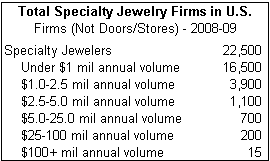
Source: IDEX Online & US Dept of Commerce
Most jewelry firms – 90 percent of the total – have annual revenues under $2.5 million. Virtually all of the firms with revenues under $1 million operate only one store; a few of those with revenues between $1 million and $2.5 million operate two or three stores.
Average Sales Per Store
Averages can be deceiving, and they can be distorted by a few high or low-volume firms. For example, Tiffany’s flagship New York store on Fifth Avenue generates about $286 million in annual sales. Further, each of Tiffany’s branch stores generates about $14 million in annual sales. If we included them in the calculation of “average sales per store” for specialty jewelers, the result would be distorted. Hence, we removed Tiffany and certain other jewelers’ average store sales from the data below.
The ranges of “annual sales per typical specialty jewelry store” (below) are based on just that: a “typical” store.
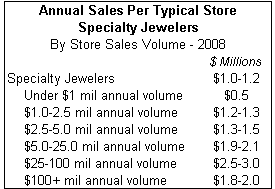 Source: IDEX Online & US Dept of Commerce |
It is interesting to note that a specialty jeweler’s sales per store peaks when the firm’s volume reaches a range of $25 million to $100 million. Here’s why: most guild jewelers operate only a few stores that generate exceptionally high sales per store. Because they typically operate only a few stores, their firm’s total annual revenues are generally under $100 million. In contrast, most specialty jewelers with annual revenues of $100 million or more are mass market jewelers like Kay (Sterling) and Zales. These mall-based stores tend to generate per-store revenues which are lower than the per-store revenues for guild jewelers.
Aggregate Revenues by Segment
The table below, Total Annual Jewelry Sales, summarizes the total sales volume of all the jewelers by annual revenue segment. For example, the revenues from all jewelers whose firms generate less than $1 million annually is about $7.5 billion, or 27 percent of total specialty jewelry revenues. In our opinion, there are no surprises on this table: the big players generate a dramatic level of industry revenue. However, the smaller jewelers also generate a large chunk of industry revenues, unlike many other retail segments which have consolidated.
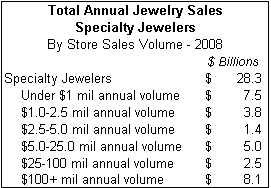 Source: IDEX Online & US Dept of Commerce |
Importance of Jewelers by Revenue Segment
The heart of the U.S. specialty jewelry industry is made up of small merchants. About 90 percent of all specialty jewelry firms report less than $2.5 million in annual revenue. Their sales, though, represent 40 percent of the specialty jewelry total.
At the top end, less than 1 percent - actually 0.06 percent – of specialty jewelers (about 15 firms) generate nearly 30 percent of specialty jewelry revenues, as the table below illustrates.
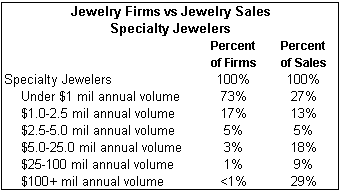 Source: IDEX Online & US Dept of Commerce |
Top Jewelers Growing Rapidly
National Jeweler now publishes a list of the “Top 50” jewelers in the U.S. In the past, its top jewelers’ list included the “Top 40.” Hence, the comparison of the number of “top” jewelers includes 50 names for 2008, but only 40 names for 1998.
In the decade that ended in 2008, the number of stores operated by the “top 40” jewelers grew by 42 percent, or about 3.6 percent at a compounded annual growth rate – from 4,537 units in 1998 to 6,433 units in 2008. If all of the stores of the top 50 in 2008 are included – 6,544 units – there was a 44 percent increase in total stores operated by America’s top 50 jewelers versus the top 40 in 1998.
In contrast, the number of stores operated by all specialty jewelers was about flat between 1998 and 2008 – at about 27,000 stores, according to the Census Bureau and the Bureau of Labor Statistics. The Jewelers Board of Trade data shows that the number of jewelry firms operating in the U.S. fell by about 17 percent in the same period, from about 27,200 firms in 1998 to about 22,600 firms in 2008. Clearly, the large jewelers are getting larger, and the small jewelers are dropping out.
The table below summarizes the change in names and units among the top jewelers between 1998 and 2008, based on National Jeweler’s census of “Top Jewelers.” A reading of those jewelers from the 1998 list is like a walk down memory lane: many are gone, but left interesting memories behind. On the other hand, a surprising number are still in business.
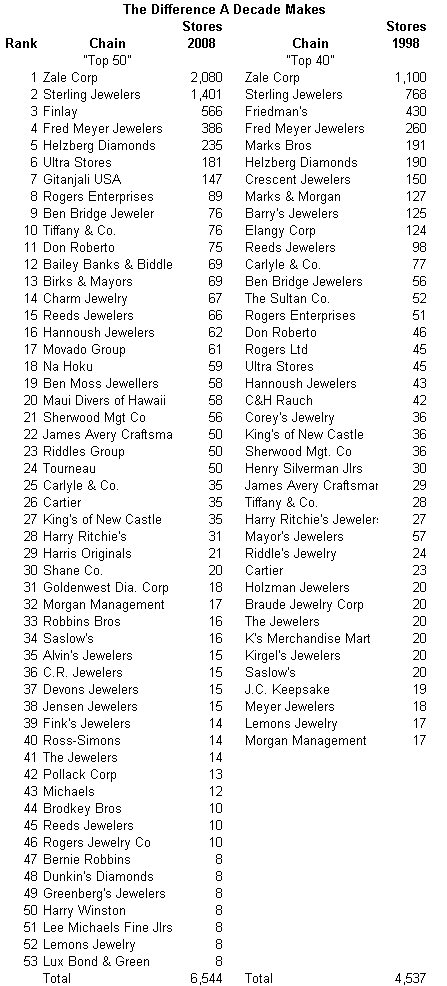
Source: National Jeweler
Specialty Jewelers Sell Almost Half of All Jewelry
In the U.S. market, just under half – 47 percent – of all jewelry is sold by specialty jewelers. Unfortunately, their market share has been declining for the past several decades. In the early 1970s, specialty jewelers had about 72 percent of the total market share. With the growth of discounters and multi-line merchants, specialty jewelers have lost market share.
The following table summarizes jewelry sales by retail outlet in the U.S.
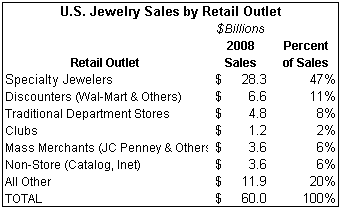 Source: IDEX Online |
Supersellers Shows Slightly Different Channel Mix for Jewelry Sales
National Jeweler’s “Supersellers” survey identifies all retailers who generate at least $100 million in annual sales. While it classifies retailers by a different set of categories versus those used by the Department of Commerce and IDEX Online Research, there is enough similarity between the retail channels to compare to the classification created from total industry sales data.
Here’s what’s important to understand: the National Jeweler survey results shown on the table below represent data relating only to jewelry retailers who generate $100 million or more in annual sales. Interestingly, however, sales by channel for these high volume retailers are reasonably similar to sales by channel for all retailers of jewelry.
Further, the table includes data for 2007 and 2008, so it is possible to compare shifts between the two years. This data is courtesy of National Jeweler.
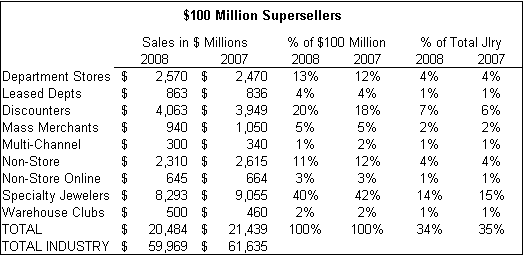
Source: IDEX Online & National Jeweler
As with total industry data, the table (above) of supersellers’ sales shows that specialty jewelers lost a disproportionate level of sales in 2008, a recessionary period. Specialty jewelers tend to lose more market share than other jewelry channels during recessions; unfortunately, they don’t ever regain that lost market share.
High-Volume Specialty Jewelers Close Stores; Sales Down in 2008
Total specialty jewelers’ revenues in 2008 were down by 6.1 percent from 2007. As the table below illustrates, high-volume specialty jewelers experienced roughly the same year-over-year decline in sales: 6 percent. Since the number of units fell by only about 4 percent, it is clear that the balance of the sales decline was due to negative same-store sales comparisons: about 2 percent.
Revenues from the top four specialty jewelers in 2008 – Sterling, Zale, Tiffany, and Finlay – represent about 11 percent of total industry sales. In contrast, the top four merchants in some other key retail categories – consumer electronics, home centers, discounters, office supplies, and a few others – generate more than 50 percent of their respective industry revenues, according to the Department of Commerce. Clearly, the jewelry industry remains one of the unconsolidated retail categories in the U.S.
The aggregate sales of these high volume specialty jewelers – $100 million or more of annual revenue – represents about 15 percent of total jewelry industry sales, based on National Jeweler’s numbers. Further, their aggregate sales represent about 32 percent of specialty jewelers’ sales. This is slightly higher than the 29 percent calculated by IDEX Online Research for all jewelers who generate $100 million or more in sales. However, this is due in part to rounding, and in part to a slightly different universe of data.
The table below summarizes relevant data for high-volume U.S. specialty jewelers. The data is courtesy of National Jeweler; IDEX Online Research provided the analysis.
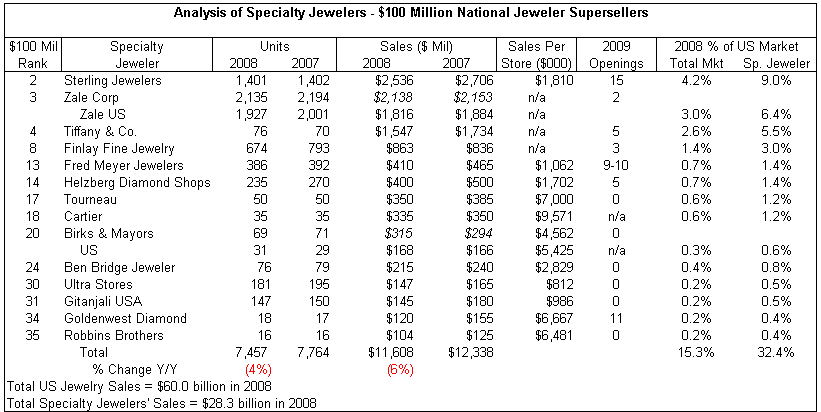
Source: National Jeweler
Implications for Vendors and Retailers
What jewelry supplier hasn’t dreamed of hitting the “big-time” with a customer that they can count on to fuel solid, consistent, above-average growth? That could be an unwise goal: they might get what they wish for, and they might not be happy!
If a supplier’s goal is to generate above-average growth, it is clear that the large specialty jewelers and multi-line retailers are growing rapidly. However, IDEX Online Research continues to recommend that vendors not allow any single retailer to become more than 20 percent of their total business – and a 15 percent cap would be even better.
One of Wal-Mart’s strategies has been to “partner” with vendors, and ostensibly help them grow. It doesn’t take long for Wal-Mart to dominate the vendor’s business. At some point, Wal-Mart’s buyers begin dictating the terms of sale. At that point, the vendor has lost control of his/her business. This story is not myth; we’ve heard it too often.
On the other hand, if you are a jewelry supplier and you are satisfied with modest, but solid growth, there are still plenty of smaller specialty jewelers in the market. Despite continuing industry consolidation, we don’t look for jewelry to become an industry dominated by one or two giants, with few smaller competitors. If vendors don’t have the capacity to service high-growth, demanding retailers, they should focus on another segment of the market.
Vendors and retailers should be important to each other. If a small vendor partners with a huge retailer, they simply aren’t going to be important. And vice versa: when a small retailer partners with a large vendor, they won’t get the service they deserve because they simply don’t have the same clout as a major high-volume retailer.
